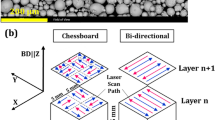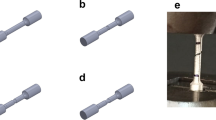Abstract
The mechanical properties of ultrafine-grained aluminum produced by equal-channel angular pressing (ECAP) are strongly influenced by strain rate. In this work, an experimental investigation of local strain rate sensitivity as it relates to microstructure was performed using a combination of scanning electron microscopy and digital image correlation. Uniaxial tension tests were carried out at 200 °C and strain rates alternating between 2.5 × 10−5 s−1 and 3.0 × 10−3 s−1. The results demonstrate that the heterogeneous microstructure generated by ECAP has a strong effect on the microstructure scale strain rate sensitivity. Deformation centered at grain boundaries separating regions of banded microstructure exhibits the greatest strain rate sensitivity. Strain rate sensitivity is limited in deformation occurring in regions of microstructure composed of ultrafine grains separated by low-angle grain boundaries. The tensile specimens all failed by shear bands at 200 °C and at room temperature they failed by necking with little plastic deformation apparent outside of the neck.









Similar content being viewed by others
References
R.Z. Valiev and T.G. Langdon: Principles of equal-channel angular pressing as a processing tool for grain refinement. Prog. Mater. Sci. 51, 881 (2006).
R.Z. Valiev, I.V. Alexandrov, Y.T. Zhu, and T.C. Lowe: Paradox of strength and ductility in metals processed by severe plastic deformation. J. Mater. Res. 17, 5 (2002).
J. Dvorak, V. Sklenicka, and Z. Horita: Microstructural evolution and mechanical properties of high purity aluminium processed by equal-channel angular pressing. Mater. Trans. 49, 15 (2008).
Y. Estrin and A. Vinogradov: Extreme grain refinement by severe plastic deformationw wealth of challenging science. Acta Mater. 61, 782 (2013).
J.M. Wheeler, V. Maier, K. Durst, M. Göken, and J. Michler: Activation parameters for deformation of ultrafine-grained aluminium as determined by indentation strain rate jumps at elevated temperature. Mater. Sci. Eng., A 585, 108 (2013).
J. May, H.W. Höppel, and M. Göken: Strain rate sensitivity of ultrafine-grained aluminium processed by severe plastic deformation. Scr. Mater. 53, 189 (2005).
N.Q. Chinh, P. Szommer, T. Csanádi, and T.G. Langdon: Flow processes at low temperatures in ultrafine-grained aluminum. Mater. Sci. Eng., A 434, 326 (2006).
A. Böhner, V. Maier, K. Durst, H.W. Höppel, and M. Göken: Macro- and nanomechanical properties and strain rate sensitivity of accumulative roll bonded and equal channel angular pressed ultrafine-grained materials. Adv. Eng. Mater. 13, 251 (2011).
H.W. Höppel, J. May, P. Eisenlohr, and M. Göken: Strain rate sensitivity of ultrafine-grained materials. Z. Metallkd. 96, 566 (2005).
I. Sabirov, M.R. Barnett, Y. Estrin, and P.D. Hodgson: The effect of strain rate on the deformation mechanisms and the strain rate sensitivity of an ultra-fine-grained Al alloy. Scr. Mater. 61, 181 (2009).
Y. Iwahashi, J. Wang, Z. Horita, M. Nemoto, and T.G. Langdon: Principle of equal-channel angular pressing for the processing of ultra-fine grained materials. Scr. Mater. 35, 143 (1996).
T.G. Langdon: The principles of grain refinement in equal-channel angular pressing. Mater. Sci. Eng., A 462, 3 (2007).
T.G. Langdon: Twenty-five years of ultrafine-grained materials: Achieving exceptional properties through grain refinement. Acta Mater. 61, 7035 (2013).
M. Furukawa, Z. Horita, and T.G. Langdon: Factors influencing the shearing patterns in equal-channel angular pressing. Mater. Sci. Eng., A 332, 97 (2002).
Y. Iwahashi, M. Furukawa, Z. Horita, M. Nemoto, and T.G. Langdon: Microstructural characteristics of ultrafine-grained aluminum produced using equal-channel angular pressing. Metall. Mater. Trans. A 29, 2245 (1998).
I.J. Beyerlein and L.S. Tóth: Texture evolution in equal-channel angular extrusion. Prog. Mater. Sci. 54, 427 (2009).
S.D. Terhune, D.L. Swisher, K. Oh-ishi, Z. Horita, T.G. Langdon, and T.R. McNelley: An investigation of microstructure and grain-boundary evolution during ECA pressing of pure aluminum. Metall. Mater. Trans. A 33, 2173 (2002).
K. Oh-ishi, A.P. Zhilyaev, and T.R. McNelley: Effect of strain path on evolution of deformation bands during ECAP of pure aluminum. Mater. Sci. Eng., A 410–411, 183 (2005).
M. Kawasaki, Z. Horita, and T.G. Langdon: Microstructural evolution in high purity aluminum processed by ECAP. Mater. Sci. Eng., A 524, 143 (2009).
D.L. Davidson: The effect of a cluster of similarly oriented grains (A supergrain) on fatigue crack initiation characteristics of clean materials. In Fourth International Conference on Very High Cycle Fatigue (VHCF-4), J.E. Allison, J.W. Jones, J.M. Larsen, and R.O. Ritchie eds.; TMS: Warrendale, PA, 2007; pp. 23–28.
A.P. Zhilyaev, D.L. Swisher, K. Oh-ishi, T.G. Langdon, and T.R. McNelley: Microtexture and microstructure evolution during processing of pure aluminum by repetitive ECAP. Mater. Sci. Eng., A 429, 137 (2006).
A.D. Kammers, J. Wongsa-Ngam, T.G. Langdon, and S. Daly: The effect of microstructure heterogeneity on the microscale deformation of ultrafine-grained aluminum. J. Mater. Res. 29, 1664 (2014).
K. Nakashima, Z. Horita, M. Nemoto, and T.G. Langdon: Development of a multi-pass facility for equal-channel angular pressing to high total strains. Mater. Sci. Eng., A 281, 82 (2000).
M. Furukawa, Y. Iwahashi, Z. Horita, M. Nemoto, and T.G. Langdon: The shearing characteristics associated with equal-channel angular pressing. Mater. Sci. Eng., A 257, 328 (1998).
K. Oh-ishi, Z. Horita, M. Furukawa, M. Nemoto, and T.G. Langdon: Optimizing the rotation conditions for grain refinement in equal-channel angular pressing. Metall. Mater. Trans. A 29, 2011 (1998).
A.D. Kammers and S. Daly: Self-assembled nanoparticle surface patterning for improved digital image correlation in a scanning electron microscope. Exp. Mech. 53, 1333 (2013).
M.A. Sutton, N. Li, D.C. Joy, A.P. Reynolds, and X. Li: Scanning electron microscopy for quantitative small and large deformation measurements. Part I: SEM imaging at magnifications from 200 to 10,000. Exp. Mech. 47, 775 (2007).
M.A. Sutton, N. Li, D. Garcia, N. Cornille, J-J. Orteu, S.R. McNeill, H.W. Schreier, X. Li, and A.P. Reynolds: Scanning electron microscopy for quantitative small and large deformation measurements. Part II: Experimental validation for magnifications from 200 to 10,000. Exp. Mech. 47, 789 (2007).
A.D. Kammers and S. Daly: Digital image correlation under scanning electron microscopy: Methodology and validation. Exp. Mech. 53, 1743 (2013).
M.A. Sutton, N. Li, D. Garcia, N. Cornille, J-J. Orteu, S.R. McNeill, H.W. Schreier, and X. Li: Metrology in a scanning electron microscope: Theoretical developments and experimental validation. Meas. Sci. Technol. 17, 2613 (2006).
Y.T. Zhu and T.C. Lowe: Observations and issues on mechanisms of grain refinement during ECAP process. Mater. Sci. Eng., A 291, 46 (2000).
ACKNOWLEDGMENTS
This work was supported by the National Science Foundation under Grant No. 092753 and by the Rackham Graduate School Non-Traditional Student Fellowship from the University of Michigan. The authors would like to acknowledge Sara Nitz for her sample preparation work and experimental assistance. Portions of this work were performed at the Electron Microbeam Analysis Laboratory (EMAL) at the University of Michigan and at the Lurie Nanofabrication Facility (LNF), a member of the National Nanotechnology Infrastructure Network, which is supported in part by the National Science Foundation. This work was also supported in part by the National Science Foundation of the United States under Grant No. DMR-1160966.
Author information
Authors and Affiliations
Corresponding author
Additional information
Supplementary Material
To view supplementary material for this article, please visit http://dx.doi.org/jmr.2015.58.
Rights and permissions
About this article
Cite this article
Kammers, A.D., Wongsa-Ngam, J., Langdon, T.G. et al. The microstructure length scale of strain rate sensitivity in ultrafine-grained aluminum. Journal of Materials Research 30, 981–992 (2015). https://doi.org/10.1557/jmr.2015.58
Received:
Accepted:
Published:
Issue Date:
DOI: https://doi.org/10.1557/jmr.2015.58









